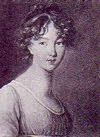This pattern is from The
Workwoman’s Guide by a Lady, London: Simpkin, Marshall, and Co., Stationer’s
Hall Court: Thomas Evans, Colmore Row, Birmingham (1838.)
The pattern, which consists of
three sentences, describes the sole as one “to be put within a shoe or a boot,”
and “is made in double knitting.” No type of wool was recommended. I Lion
Brand Fisherman’s Wool in Natural as it is sturdy and works well for
reproductions. There is some guidance, however, in
the number of stitches to be “set on” and the number of rows to be knit.
No needle type or size was
suggested so I had to experiment to achieve any sort of sole above the size of
an infant’s shoe. Finally settling on 6.5mm/US 10 ½ sized needles, this pair would fit in the shoes of young child, measuring
just over 5 ½” long and about 2 ½” wide across the upper part of the
foot. As with many patterns from the past, this one is probably a set of
guidelines, and the experienced knitter would adapt it for the required size.
After knitting, the sole “must
be brought into shape by taking it in with the galloon, when wanted to be
narrowed.” I assisted this process by shaping my muslin soles. I also closed
off the top of the foot with a drawstring.
The last steps are sewing the
sole to “ a piece of stiff muslin of the proper shape, and bound all round with
ribbon.”
An illustration for the sole appears on Plate 21, Figure 39 of the book.
An illustration for the sole appears on Plate 21, Figure 39 of the book.








3 comments:
I wonder if these were meant to improve fit/comfort, or to make a pair of shoes/boots warmer? Or, I suppose, to be a removable and separately-washable part, in cases where someone gets particularly sweaty and smelly in the sole area ...
My guess is that the sole was to increase the warmth of the shoe. People in the 19th century weren't so concerned about smells as we are.
My guess is warmth, too.
Post a Comment